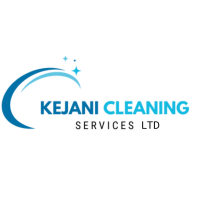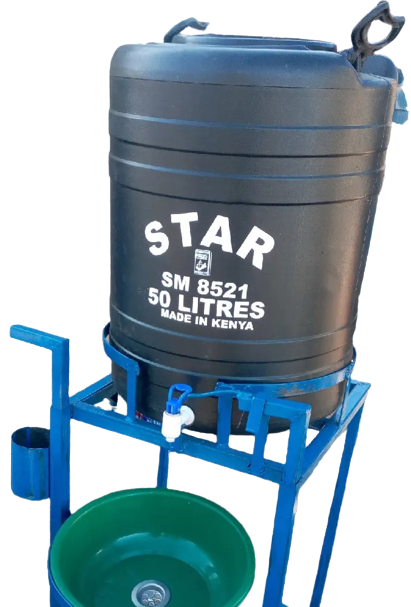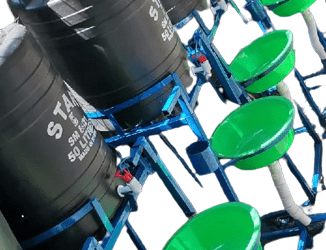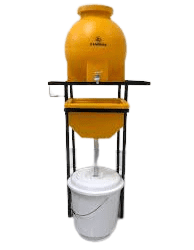Introduction
In any workplace—especially those handling chemicals, food, healthcare, or construction—wash stations are critical safety tools. Understanding how they work, where to install them, and how often to inspect them is not just best practice; it’s required for compliance with OSHA standards and Kenya’s occupational safety laws.
Whether you’re planning to install hand washing sinks or eye wash stations, this guide walks you through everything you need to know.
1. How Do Hand Washing Stations Work?
Hand washing stations provide a clean, convenient way to maintain hygiene in indoor or outdoor settings. These units are often connected to a direct water source or built with water tanks for portable use.
✅ Main Components:
-
Water supply (either piped or from a tank)
-
Soap dispenser (liquid, foam, or gel)
-
Paper towels or hand dryers
-
Wastewater drainage
-
Foot pedals or taps for hands-free operation
✅ How It Works:
-
User dispenses water manually or with a foot pedal.
-
Soap is applied and rinsed with clean water.
-
Water drains into a connected outlet or waste tank.
-
A paper towel is used to dry hands or an air dryer is activated.
2. How Do Eye Wash Stations Work?
Eye wash stations are safety fixtures designed to flush chemicals or debris out of a person’s eyes in case of exposure or accidents.
✅ Components:
-
Dual nozzles or spray heads for both eyes
-
Push handle or foot pedal to activate
-
Steady water stream at low pressure to avoid eye damage
-
Drainage or catch basin to manage wastewater
✅ How It Works:
-
The user pushes a lever or stands on a foot pedal.
-
Water flows immediately through both nozzles.
-
The person leans forward and keeps eyes open for 15 minutes (as per safety protocols).
-
Contaminants are flushed out gently and effectively.
Important: These stations must provide at least 1.5 liters per minute (LPM) for 15 minutes as per ANSI/OSHA standards.
3. How Do Portable Hand Washing Stations Work?
Portable hand washing stations are used in locations without plumbing—like events, outdoor work sites, or temporary installations.
✅ Key Features:
-
Fresh water tank (usually 10–50 liters)
-
Foot pump or hand pump for hands-free water flow
-
Soap dispenser
-
Paper towel holder
-
Used water tank (separate from fresh tank)
✅ How It Works:
-
User pumps water using foot pedal or lever.
-
Soap is applied and rinsed.
-
Greywater flows into the built-in waste tank.
-
Units are cleaned and refilled periodically.
Portable units are great for schools, construction sites, and rural hospitals.
4. How Does an Eye Wash Station Work? (Quick Summary)
Eye wash stations:
-
Provide immediate irrigation to eyes
-
Are activated by a push lever
-
Deliver water via twin nozzles
-
Must maintain a minimum of 15 minutes of continuous flow
-
Prevent long-term eye damage in case of chemical contact
5. Where Should Wash Stations Be Located?
Proper placement is essential for accessibility and compliance:
🧼 Hand Washing Stations:
-
Near toilets, canteens, and food prep areas
-
At building entrances/exits
-
Inside healthcare or school facilities
-
At every construction site zone
👁️ Eye Wash Stations:
-
Within 10 seconds or 15 meters of hazardous chemical areas
-
On the same level as the hazard zone—no stairs or barriers
-
Clearly marked and unobstructed
-
With proper lighting and signage
6. How Often Should Wash Stations Be Checked or Activated?
For safety and functionality, weekly activation is recommended—especially for emergency fixtures like eye wash units.
✅ OSHA/ANSI Guidelines:
-
Eye wash stations: Activate once per week to ensure water flow and clear out stagnant water.
-
Hand wash stations: Check daily for soap, water, towels, and cleanliness.
7. How Often Should Wash Stations Be Inspected?
Regular inspections prevent malfunction and ensure compliance.
🗓️ Suggested Schedule:
-
Daily: For high-use hand washing stations (check supplies, leaks, and sanitation)
-
Weekly: Eye wash stations (activate to flush systems)
-
Monthly: Full inspection for cleanliness, drainage, and signage
-
Quarterly: Maintenance checks by technical teams
8. How Often Should Wash Stations in Chemical Showers Be Inspected?
Chemical showers and wash stations should follow stringent inspection rules due to the danger involved.
⚠️ Recommended Practice:
-
Activate and inspect weekly
-
Run water for at least 3 minutes
-
Check for corrosion, clogs, or low pressure
-
Keep a logbook to record inspections
Failure to comply may result in liability in case of accidents or DOSHS penalties.
Conclusion
Whether it’s a hand washing station at a construction site or an eye wash unit in a lab, understanding how these systems work—and keeping them operational—is crucial. Employers, school heads, event managers, and safety officers must stay compliant with local and OSHA regulations.
✅ Need Help Installing or Managing Wash Stations?
At Kejani Cleaning Services Limited, we supply, install, and maintain hand washing and eye wash stations for:
-
Construction sites
-
Industrial plants
-
Schools & hospitals
-
Events & religious centers
-
Restaurants and malls
📍Serving: Kenya, Uganda, Tanzania, Rwanda, Ethiopia & more.
📞 Call/WhatsApp: +254 115 887 085
🌐 www.kejanicleaning.co.ke
Stay safe. Stay compliant. Stay clean.




0 Comments